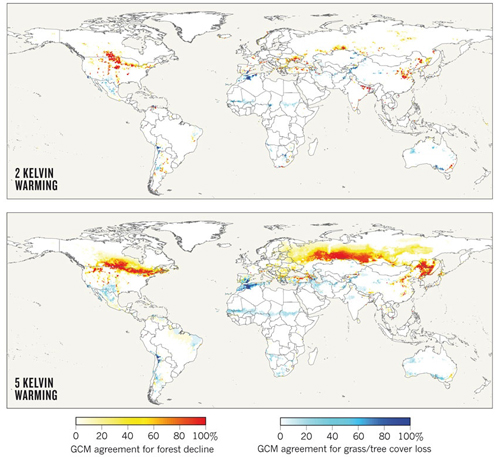There is a growing urgency to produce global projections of how a warming climate could affect life on Earth.
“Impact research is lagging behind physical climate sciences,” says Pavel Kabat, director of the International Institute for Applied Systems Analysis (IIASA) in Austria. “Impact models have never been global, and their output is often sketchy. It is a matter of responsibility to society that we do better.”
Time is running out for researchers hoping to contribute impact simulations to the IPCC’s Fifth Assessment Report (scheduled for publication in 2014). So last month, the IIASA and the Potsdam Institute for Climate Impact Research (PIK) started a project to compare climate-impact models collected from more than two dozen research groups in eight countries. The Inter-Sectoral Impact Model Intercomparison Project (ISI-MIP) will integrate climate data from state-of-the-art models, using a range of greenhouse-gas emission scenarios (models used in the project can be found here). Because the various emissions scenarios result in a range of projected global temperature increases, potential impacts also can vary widely across a range of scenarios. It is hoped that the project will clarify systematic biases that can cause models to produce disparate results.
The models will investigate the effects of climate change on global agriculture, water supplies, vegetation, and health. Results are due by July 1, and reports on each of the four impact areas are scheduled to be completed by January of 2013. This means the data could be available for the IPCC’s next report–which “will make a real difference for the assessment process,” notes Chris Field of the Carnegie Institution for Science, cochair of IPCC Working Group II. “I greatly appreciate the initiative required to get this activity underway, and I appreciate the commitment to fast-track components that will yield results in time for inclusion in the IPCC Fifth Assessment Report.”
The ISI-MIP is scheduled to continue into 2013 and could be expanded to analyze climatic impacts on transport and energy infrastructures.

ipcc
IPCC's New Special Report: Adapt to Extremes, but Prepare for the Presentation
For a first reaction to the new Intergovernmental Panel on Climate Change special report, Special Report on Managing the Risks of Extreme Events and Disasters to Advance Climate Change Adaptation, read William Hooke’s full post here, but keep in mind his take away message for now:
The world need not just this and the other IPCC reports themselves but also the body of diverse analysis and reaction the reports trigger. IPCC reports should and do stimulate thought and action. They don’t prescribe it.
What should you and I keep in mind as we read?
1. We should remember that the Earth does its business through extreme events and always has. Extremes are not suspensions of the normal order; they are its fulfillment.
2. Extremes leave no sphere of the natural or social or technological world unaffected and the disruptions in all those normally distinct spheres intereact with each other, compounding the challenge.
3. Social change matters more to what extreme events and disasters portend for our future than does climate change. .
4. We’ve got to get past reacting to the crisis of the moment
This will be good preparation not only for reading the full report when it’s available online in February 2012 (the summary is now available here) but also for discussions with Roger Pulwarty and colleagues when the present the reports findings on the first day of the upcoming AMS Annual Meeting in New Orleans (23 January, 11:30 a.m., Room 243). If you’re interested in hearing from the report authors now, check out the video from Friday’s press conference: